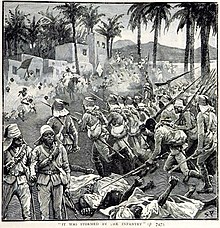Battle of Ferkeh
| Battle of Ferkeh | |||||||
|---|---|---|---|---|---|---|---|
| Part of the Mahdist War | |||||||
 Anglo-Egyptian troops storm the village of Ferkeh (illustration from a British book) |
|||||||
|
|||||||
| Belligerents | |||||||
|
|
|
||||||
| Commanders and leaders | |||||||
| Osman Azrak Hammuda (KIA) |
Sir Herbert Kitchener | ||||||
| Strength | |||||||
| 3,000–4,000 men | 9,000–9,500 men | ||||||
| Casualties and losses | |||||||
| 44 emirs killed 4 emirs captured 800–1,500 soldiers killed 500 soldiers wounded 500–600 POWs |
20 soldiers killed 81–83 soldiers wounded |
||||||
The Battle of Ferkeh (or Firket) occurred during the Mahdist War when an army of the Mahdist Sudanese was surprised and wiped out by the British and Egyptian forces under Sir Herbert Kitchener on 7 June 1896.
In 1896, as part of the Sudan campaign, Kitchener's Anglo-Egyptian force was advancing on Dongola, in Northern Sudan. Ferkeh was a small fortified village on the banks of the Nile. It was the first important Mahdist position they encountered. At the time, it was occupied by 3,000 Mahdist warriors, led by the Emirs Hammuda and Osman Azrak.
Kitchener's force, nominally in service of the Khedive of Egypt, but in fact under direct British control, was composed of Egyptian and Sudanese soldiers, led by British officers. It numbered 9,000 men, accompanied by three batteries of field guns and one battery of Maxim guns.
Kitchener divided his force into two columns. One was formed mostly of infantry, and had to march along the Nile to attack Ferkeh from the North. The other consisted of cavalry, camel-mounted infantry and horse artillery units and was sent through the desert to attack from the South-East. Both columns departed in the evening of the 6th, and marched through the night, deploying at dawn in the morning of the 7th.
The attack caught the Mahdists completely by surprise, and they made only uncoordinated attacks against the deploying Egyptians, during which Hammuda was killed. Many of the Mahdists then turned and fled. The cavalry column should have cut off their retreat, but they were hidden from view by the terrain, and many made good their escape along the Nile, including Osman Azrak. Other Mahdists stayed in their fortifications in the village, and fought to the bitter end. The Egyptians had to clear the position with bayonets.
The battle lasted less than three hours—from 04:30 to 07:20—and resulted in the deaths of 20 Egyptians and 800 to 1000 Mahdists. It was the first significant action during the Sudan campaign.
...
Wikipedia
